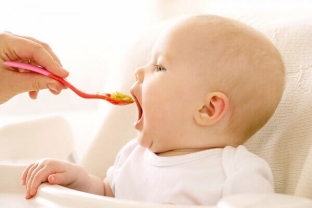Young mothers often get lost when it comes to feeding their baby. If the baby eats only mixtures and breast milk, there are practically no problems. When the child becomes older and the introduction of other products is necessary, not everyone can understand exactly how to properly distribute food intake. The easiest way is to make a menu for the week and follow it. We will consider an example of a child's menu at 1 year of age: what should be included in it, when and in what quantities. How exactly to introduce complementary foods and is it suitable for everyone?
How to introduce complementary foods correctly?
At the average age of 6 months, a baby is ready to eat other foods besides formula and breast milk. It develops rapidly, so it needs additional resources for healthy growth. If the baby is not gaining weight well, then you can start feeding at 5 months.
One of the indicators of the right time to start complementary foods is the appearance of the first tooth. It is believed that its presence – a signal that the baby is ready for a new food. But if the teeth have not appeared even at 9 months, complementary foods must still be introduced.
You can start with fruit and vegetable purees. If the baby is not gaining weight well, then the reception of cereals is indicated. In any case, do not choose vegetables and fruits with a bright color to begin with, they can cause allergies at first or intestinal problems (colic, constipation, diarrhea, etc.) It is better to give something neutral: zucchini, broccoli, potatoes , cauliflower. Then you can switch to pumpkin, carrots and beets.
If you decide to give an apple, let it be green, recommends estet-portal.com. You need to start with a coffee or teaspoon, gradually adding the amount of food. Do not forget about fermented milk products, they are good for the intestinal microflora and will help the proper absorption of other foods. Already at 10 months, you can replace 3 meals with complementary foods.
Closer to eleven months, you can add vegetable soups and soufflés. By twelve months, meat and fish can be taken. You can add fruit juices, compotes, fruit drinks.
When introducing complementary foods, adhere to the rule that the baby should eat from a spoon, and not drink puree from a bottle or drinker. Be sure to accustom him to the process of chewing food.

What should a child's menu include per year?
The child's menu per year should be quite varied. It should include: proteins, fats, carbohydrates, vitamins and trace elements. If complementary foods were introduced correctly, then by the 1st year, the baby should eat almost all food (excluding harmful ingredients), except for those to which he is allergic. If you have problems with complementary foods, be sure to consult your pediatrician, you may not be doing it right or adding one or another product too early.
This is how the menu should be in one year of a child's life
- Breakfast – 8.00, milk porridge (200 gr), half an egg yolk and tea (75 ml), possibly fruit juice;
- Lunch-12.00, vegetable soup (100 ml), vegetable puree (125 gr), steamed minced meat or fish dish (70 gr), fruit or vegetable juice (75 ml);
- Snack-4 pm, cottage cheese (100 g), fruit puree (50 g) or just fruit (50 g), 150 Narine or other fermented milk drink;
- Dinner – 19.00, vegetable puree (100 gr) or pasta (no more than 1-2 times a week), fermented milk drink (100 ml);
- Evening feeding – 22.00-24.00, fermented milk drink or yogurt (200 ml).
If your baby is breastfeeding or needs bottled formula between feeds, don't stop him. With the normal weight of the child, this is even necessary. A sharp transition to only complementary foods can adversely affect his emotional and physical condition.
Sometimes, it may seem to you that the child's appetite is reduced because he consumes less of one or another food. But there is no need to panic, because the food that you give in complementary foods is much more satisfying than breast milk and milk formulas.
Don't insist if the baby doesn't want to eat this or that dish. You can create an aversion to eating. Also a big mistake of parents is the addition of sugar (intentional sweetening of food) so that the child eats better. Yes, of course, the baby will happily swallow sweet food or compote, but at the same time, you will not develop the eating habits that are necessary for a healthy diet. And, eating too much, the baby will simply gain unnecessary kilograms.
Introduce complementary foods correctly and competently with estet-portal.com.






Add a comment